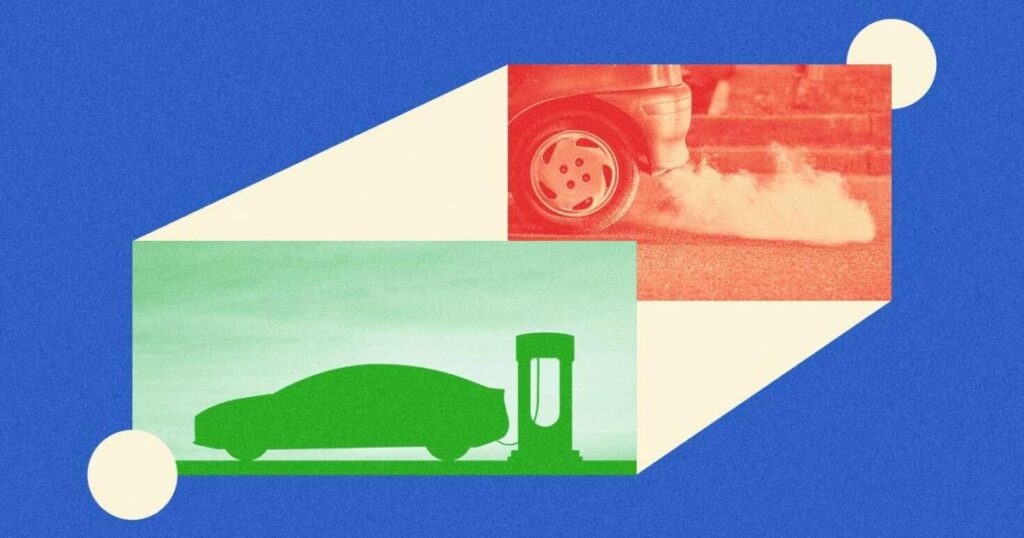Newly announced EPA tailpipe emissions rules: What you need to know
3 min read
The Environmental Protection Agency (EPA) announced new tailpipe emissions regulations today. The rules aim to cut down current emissions by up to 50 percent, while increasing the long-term viability of the EV and hybrid vehicle marketplace.
First proposed by the EPA in April 2023, the “Multi Pollutant Emissions Standards for Model Years 2027 and Later Light-Duty and Medium Duty Vehicles” build upon existing smog-forming pollution, soot and carbon dioxide emissions regulations that originally impacted cars and light trucks for model years 2023 to 2026. The new, technology-neutral rules will impact vehicle models — ranging from cars to SUVs to pickup trucks — from 2027 to 2032, with the EPA currently working on finalizing similar rules for models past 2032.
“The goal is to say that these new vehicles have to be cleaner than the previous ones,” said Corey Cantor, senior associate of electric vehicles at BloombergNEF, to GreenBiz before the new rules were announced
“The pollution standard for CO2 for light-duty vehicles by 2032 will be half of what it is for model year 2026 [light-duty vehicles],” confirmed a senior administration official on a call with journalists.
In the new rules, the EPA cites the availability of advanced low-emission technology as one of the many reasons behind the regulations.
“EPA’s final rule gives manufacturers the flexibility to efficiently reduce emissions and meet the performance-based standards through the mix of technologies they decide is best for them and their customers,” according to a press release provided to reporters. Those technologies include both fully electric and plug-in hybrid vehicles.
“[The Biden administration] says ‘here’s a CO2 target,’… you go figure out the best way to meet it,” said Cantor. The original equipment manufacturer (OEM) just needs to document how the new product doesn’t exceed the average limit of emissions stated by the EPA.
Overall, the rules are intended to reduce oil exports by 20 billion barrels through 2055 and avoid more than 7 billion tons of CO2 emissions.
Why this is important
As of 2023, the U.S. transportation sector contributed 39 percent of the country’s total emissions — the highest source of greenhouse gases. The proposed rules moves the Biden administration one step closer toward its goal to reduce emissions by 50 to 52 percent of 2005 levels by 2030.
The EPA is also estimating that with the adoption of the rules, consumer use of EVs will increase, with 67 percent of new light-duty vehicles on the road in 2032 being electric. Ultimately, the rules will beneficially impact EV production and spur consumer interest.
The trends are already pointing to a continued increase in EV sales. The latest market recap from the Alliance for Automotive Innovation shows that EV sales have been steadily increasing through the third quarter of 2023, up a total of 66 percent from Q3 2022.
And EVs aren’t the only eligible technology that manufacturers can use to ensure compliance.
“I think what you’ve seen in the marketplace is a real movement towards highly capable plug-in hybrid vehicles,” said a senior administration official, while reaffirming that incentives toward any battery-powered vehicles provided by both the Bipartisan Infrastructure Law and the Inflation Reduction Act (IRA) are still in play.
“You’ve got a 45X [IRA] tax credit that incentivizes manufacturing batteries that can go into these plug-in hybrid vehicles,” said the senior administration official on the press call.
The EPA also said in the press release that it “projects an increase in US auto manufacturing employment in response to these final standards.” Currently, there are 2 million auto manufacturing jobs in the U.S., according to the Alliance for Automotive Innovation.
The effect of administration changes
The rules have been released by President Joe Biden’s EPA, but should a second Trump administration occur, it’s likely the Republican president will attempt to roll back emissions standards. But the process isn’t as straightforward as it appears.
“When [an administration] rolls standards back, it’s not as easy as an executive order…that undoing would have to go through a rulemaking process of its own,” said Cantor.
There are also other factors in play, including likely lawsuits filed against the rule rollback and California’s state emission standards. So automakers shouldn’t wait to comply under the assumption that rules are only temporary.
“There’s a higher cost to waiting [to transition to lower-emissions vehicles] now compared to 2016,” Cantor said, referring to the fuel economy targets set by the Obama administration.
Plus, there are “millions of dollars in fines” for noncompliance, he said.




